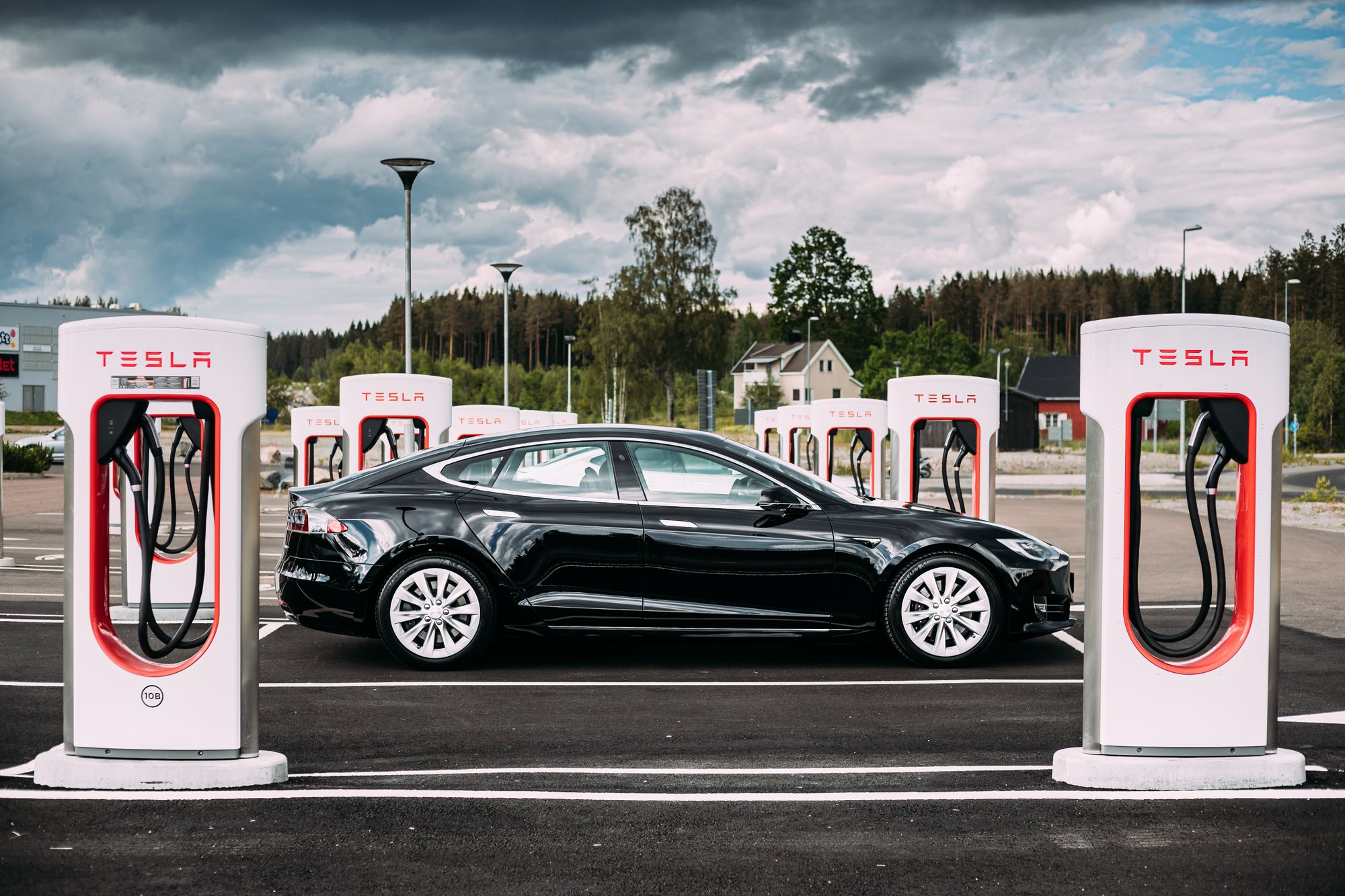Are you a Tesla owner looking to better understand how to charge your Tesla? Asking the simple question of how to charge a Tesla might seem straightforward enough, and in a lot of ways, it is; however, as a Tesla owner, you actually have access to many different ways to charge your Tesla. In the following sections, we will investigate:
- How Tesla Charging Works
- Home Charging Versus Public Charging
- Different Types Tesla Chargers
- Nema Adapters
- Tesla Wall Connector
- Mobile Backup Charger
How Tesla Charging Works
Teslas, and all EVs for that matter, are designed on the basic principle of energizing and storing energy within an on-board battery and then discharging the stored energy in the battery to power the vehicle. Tesla is unique in a lot of ways within the EV market for its proprietary Lithium-Ion-based batteries. These Li-Ion batteries are designed to last for an extremely long time, incur minimal damage over their lifetime and provide better energy efficiency than many other EV manufacturers in the market today.
Another interesting note on how Tesla charging works is that Tesla vehicles are actually powered by thousands of smaller Li-Ion batteries that make up one large aggregate battery. Depending on the model, Teslas come equipped with between 6,000 and 7,000 individual Li-Ion batteries in each vehicle. These batteries are organized into a battery network such that all of these batteries are charged in parallel and discharge in parallel. One great benefit to this is that Tesla can minimize the cost of battery failure. If a single cell or bay of cells were to fail, this is going to incur a much lower cost than replacing a single massive battery.
Home Charging Versus Public Charging

As many Tesla owners may be aware, Teslas can be charged either in the home or through a public charging network. Home charging and public charging each provide their own unique benefit to Tesla owners, so these options most certainly deserve some explanation.
Home Charging
In terms of ease of use, home charging is going to be your best option. Having the ability to charge your Tesla in your home is going to lend to ease and dependability. Once you’ve used your Tesla for some time, you’ll get a sense of your standard daily commute and how long you need to charge your Tesla to meet your daily driving requirements . Aside from the assumed ease of use, home charging does offer various other benefits compared to public charging. Home Charging Benefits:
- You can select from a variety of in-home chargers to meet your unique charging needs.
- Electric companies offer a variety of rate plans that can help you minimize charging costs.
- Charging automation services through third-party services
- Charging at home removes the need to travel elsewhere to charge- or to wait for public chargers to become available.
Public Charging
Luckily for Tesla owners, public charging fills the gaps where home charging falls short. The value of public charging is noted in the following list of benefits:
Public Charging Benefits:
- Public charging can provide extremely fast charging times that are far superior to home charging through the Tesla SuperCharger option.
- Public charging can be a lifesaver if you are in a pinch and need to charge while away from home.
- Public charging is almost a sure necessity while traveling great distances such as road trips or traveling between cities and state lines.
Public Charger Options
Tesla SuperCharger
It is important to note that there are different types of public chargers. As previously mentioned, SuperChargers offer extremely fast charging capabilities. Recently, Tesla has made a tremendous investment in the SuperCharger network. So much so that Tesla owners have access to over 20,000 SuperChargers globally. The intention of this SuperCharger network is to ensure that Tesla owners are never out of range of a public charger. That said, new SuperCharger stations are being built all the time with the intention to have at least one Tesla SuperCharger every 200 miles.
Tesla Destination Charging
Tesla Destination Charging is the concept of installing public Tesla charging stations at locations where Tesla owners may be staying for long periods of time. Good examples of destination charging locations would be hotels, office parking lots, movie theaters or any other parking location where Tesla owners may be spending extended periods of time.
Different types of Tesla Chargers
To provide flexibility to Tesla owners, Tesla provides three standard charging options to charge one’s Tesla. Tesla Charger’s Level 1, Level 2, and Level 3 (Direct Current or SuperCharger) are categorically different based on the voltage each charger applies. As a Tesla owner, it’s important to understand each charger’s influence on charge time and how each may fit your unique needs.
Level 1 Charger
The Level 1 charger is the introductory option for charging since every Tesla comes equipped with a Level 1 charger. This charger is simply an adapter that connects your Tesla to a 110-volt NEMA home outlet. Although it’s great that this adapter comes with your Tesla, it may end up causing you some headaches related to charging time. The Level 1 charger is also known as a ‘trickle charger’ due to its slow charging speeds and low charging efficiency.
The 110-volt adapter delivers 120 volts and 15-20 amps of current to your Tesla. This provides only 2-3 miles per hour of charging time, resulting in some extremely lackluster results. To give a sense of the time required to charge a Tesla with a Level 1 Charger, we’ve put together a small graph that outlines Level 1 charging times with some common Tesla Models.
Level 1 Charge Times for Tesla Standard Models Charging from 50% to 90%:
Level 2 Charger
The Level 2 charger option is going to be a great after-market option for Tesla owners looking to move from the Level 1 110-volt NEMA adapter to something that delivers more charge in a shorter amount of time.
The Level 2 charger connects to a variety of 240-volt NEMA outlets. On average, this Level 2 charger adapter applies 240 volts and up to 80 amps of current to your Tesla. In doing so, this 240-volt charger will provide 9 to 52 miles per hour charge, providing a great enhancement to the Level 1 charger.
Level 2 Charge Times for Tesla Standard Models Charging from 50% to 90%:
Level 3 Charger
The Level 3 charger, also known as DC or Direct Current Charging, or the SuperCharger, is going to be the fastest charger available from Tesla. It is important to note that this charger type is not offered as a home-based charger simply because homes are not equipped with a source voltage to support this charger configuration. The Tesla DC Charger or SuperCharger offers a whopping 480 volts and 500 amps of direct current for charging.
SuperCharger Times for Tesla Standard Models Charging from 30% to 90%:
Wall Connector
The Tesla Wall Connector is another great option for charging your Tesla. The Tesla Wall Connector is a sleek wall-mounted charging station that is designed to provide the fastest in-home charging available. Noted from Tesla’s support page, the Tesla Wall Connector offers the following features:
- Up to 44 miles (77 km) of range per hour of charge
- Compatible with Model S, Model 3, Model X, and Model Y
- Up to 11.5 kW / 48 amp output
- Customizable power levels on a range of circuit breakers
- Compatible with any home electrical system
- Wi-Fi connectivity (2.4 GHz 802.11 b/g/n)
- Approved for indoor and outdoor installation
- Lightweight 18' (2.6m) cable length
- Tempered white glass faceplate
Aside from the noted benefits above, the Tesla Wall Charger will also provide about a 16% increased charge time compared to the 240-volt NEMA Level 2 option. Today, Tesla owners have access to the Gen 2 Wall Connector and the Gen 3 Wall Connector, each possessing some unique features. If you’d like a deep dive on the gen 3 Wall Connector, consider checking out our article Is The Tesla Gen 3 Wall Connector Worth It? Here’s a quick breakdown of the different features between the Gen 2 and Gen 3 Wall Connector.
Gen 2 Wall Connector Features
- Black or grey plastic housing
- Supports a higher amp setting, thus providing faster charge times
- Comes equipped with a longer 24-foot cable
- Can Charge two Teslas at once
Gen 3 Wall Connector Features
- Updated white plastic housing
- Supports a lower amp limit, charging slower than the Gen 2
- Comes equipped with a shorter 18-foot cable
- Exhibits some unreliability issues in comparison to the Gen 2
Mobile Backup Charger
Last on the list regarding charger options is the Tesla Mobile Connector. The Tesla Mobile Connector is a bundle that comes equipped with every Tesla providing Tesla owners the ability to charge from any NEMA-14-50 outlet. The idea behind this charger option is to allowTesla owners to charge their Teslas in a pinch if they happen to near an empty battery far from a home or public charger. In this scenario, Tesla owners simply need a standard NEMA-14-50 outlet to charge their Tesla via the Mobile Connector. Often, Tesla owners will use this option to recover enough battery charge to get home or get to the closest SuperCharger.
Next Steps
We hope this article has provided you an introduction to the various options a Tesla owner has in regards to how to charge your Tesla. If you would like to know not only how to charge, but when to charge as well, there is an app that can help with that as well. Optiwatt is a free app that schedules your Tesla to charge for the cheapest price possible. If you are looking to learn more, read our article The Comprehensive Guide to Maximizing your Tesla’s Battery Efficiency and Battery Life.


